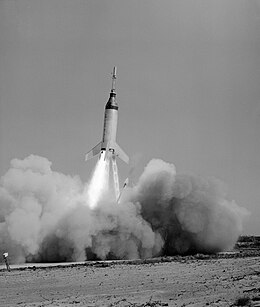Little Joe 5B was an uncrewed launch escape system test of the Mercury spacecraft, conducted as part of the US Mercury program. The mission used production Mercury spacecraft # 14A. The mission was launched April 28, 1961, from Wallops Island, Virginia. The Little Joe 5B flew to an apogee of 2.8 miles (4.5 km) and a range of 9 miles (14 km). The mission lasted 5 minutes 25 seconds. Maximum speed was 1,780 mph (2865 km/h) and acceleration was 10 g (98 m/s²). The mission was a success and Mercury spacecraft # 14A was recovered.[1]
 Launch of Little Joe 5B from Wallops Island | |
| Mission type | Abort test |
|---|---|
| Operator | NASA |
| Mission duration | 5 minutes, 25 seconds |
| Distance travelled | 14 kilometres (9 mi) |
| Apogee | 4.5 kilometres (2.8 mi) |
| Spacecraft properties | |
| Spacecraft | Mercury No.14 |
| Manufacturer | McDonnell Aircraft |
| Launch mass | 1,141 kilograms (2,515 lb) |
| Start of mission | |
| Launch date | April 28, 1961, 14:03 UTC |
| Rocket | Little Joe |
| Launch site | Wallops LA-4 |
| End of mission | |
| Landing date | April 28, 1961, 14:08 UTC |

Project Mercury Abort Tests | |
Mercury spacecraft #14A used in the Little Joe 5B mission, is on display at the Virginia Air and Space Center in Hampton, Virginia.[2]
See also
editReferences
edit- ^ Loyd S. Swenson Jr.; James M. Grimwood; Charles C. Alexander (1966). "10". This New Ocean: A History of Project Mercury - NASA SP-4201. NASA Special Publication-4201 in the NASA History Series. p. 9. Archived from the original on 2009-04-07. Retrieved 26 June 2013.
- ^ "Spacecraft". Virginia Air & Space Science Center. Retrieved March 20, 2023.
This article incorporates public domain material from websites or documents of the National Aeronautics and Space Administration.